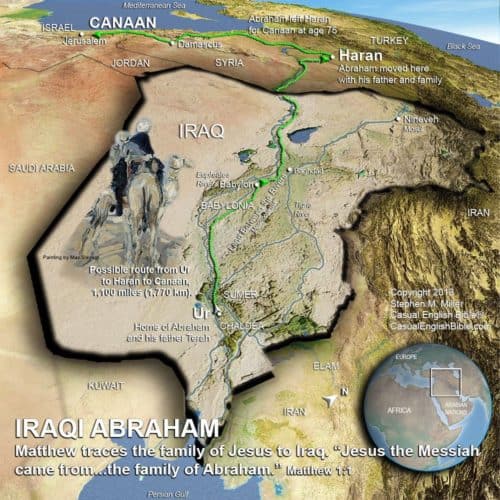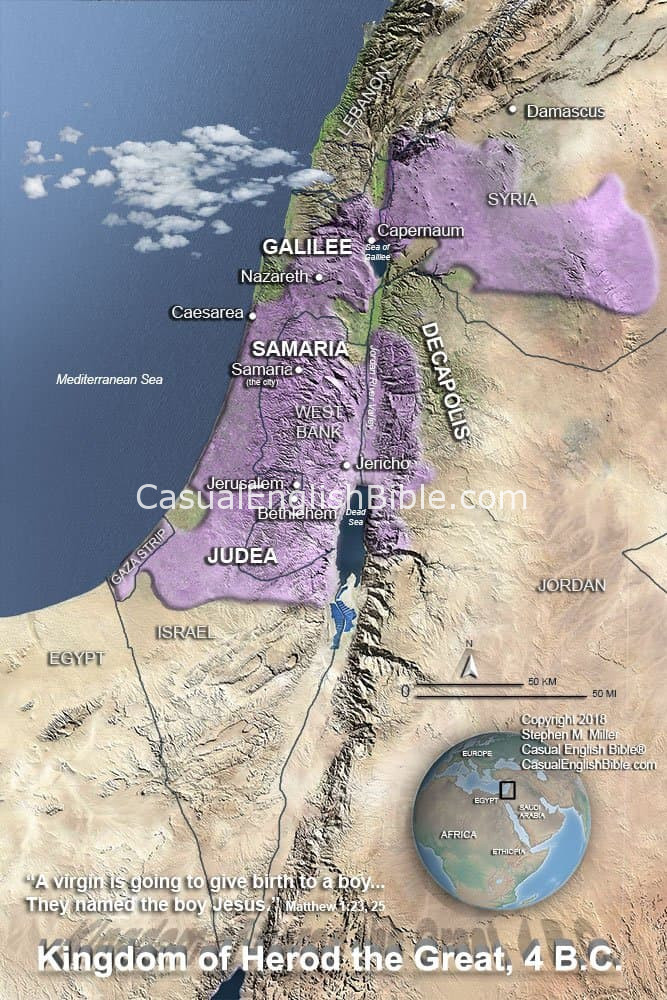Matthew 1
Royal pedigree of Jesus
Joseph’s Family Tree
1Jesus the Messiah came from the family of King David. Both belonged to the family of Abraham. Here’s what the family tree of Jesus looks like, starting with Abraham.Branch 1
2Abraham had a son, Isaac. [1] Isaac produced Jacob. Jacob produced Judah and other sons. [2] 3Judah and Tamar had two sons: Perez and Zerah. Perez produced Hezron. Hezron produced Ram. 4Ram had a son, Amminadab. Amminadab produced Nahshon. Nahshon produced Salmon. 5Salmon and Rahab had a son, Boaz. Boaz and Ruth produced Obed. Obed produced Jesse.Branch 2
6Jesse had a son, King David. David and Bathsheba, who was Uriah’s widow, produced Solomon. 7Solomon had a son, Rehoboam. Rehoboam produced Abijah. Abijah produced Asa. 8Asa had a son, Jehoshaphat. Jehoshaphat produced Jehoram. Jehoram produced Uzziah. 9Uzziah had a son, Jotham. Jotham produced Ahaz. Ahaz produced Hezekiah. 10Hezekiah had a son, Manasseh. Manasseh produced Amon. Amon produced Josiah. 11When Babylonian invaders deported the Jewish people to Babylon, Josiah had several sons, including Jeconiah.Branch 3
12While Jews were living in exile in Babylon, Jeconiah had a son, Shealtiel. Shealtiel produced Zerubbabel. 13Zerubbabel had a son, Abiud. Abiud produced Eliakim. Eliakim produced Azor. 14Azor had a son, Zadok. Zadok produced Achim. Achim produced Eliud. 15Eliud had a son, Eleazar. Eleazar produced Matthan. Matthan produced Jacob. 16Jacob had a son, Joseph. Joseph became the husband of Mary. She gave birth to Jesus, who became known as the Messiah.17This list shows there were 14 generations, three times over. From Abraham to David, 14 generations. From David to the Babylonian deportation, 14 generations. From the Babylonian deportation until the Messiah, 14 generations.
It’s a Boy: Jesus Is Born
18This is the story about the birth of Jesus the Messiah. Mary got pregnant when she was engaged to Joseph, before they were intimate. Her pregnancy was through the Holy Spirit.19Joseph was a man who honored God by the way he lived. He decided to release Mary from the agreement they made to get married. But he decided to do it privately because he didn’t want to publicly humiliate her.
20While Joseph was trying to figure out how best to break off the engagement, he had a dream. An angel came to him and said, “Joseph of David’s family, don’t get cold feet. You have nothing to fear with Mary. She’s carrying a child of the Holy Spirit. 21Mary will give birth to a son. Call him Jesus because he’s going to save his people from the sins they’ve committed.”
22It happened this way to fulfill the prophecy: 23“Look, a virgin [3] is going to give birth to a boy. They’re going to name him Immanuel.” [4] The name translates: “God is here with us.”
24When Joseph woke up, he did what the angel of the Lord told him to do. He went through with the marriage. 25Joseph didn’t have sexual relations with Mary until after she gave birth to her son. They named the boy Jesus.
Footnotes
Matthew more literally describes Jesus as the “son of Abraham” and the “son of David.” Scholars say Matthew did this to link Jesus to the promises God made to Abraham and David. His description links Jesus to the blessings God promises to the descendants of Abraham, including: “All the families on the planet will be better off because of you and your family. You are going to make this world a better place” (Genesis 12:3). By Jesus’s time, “son of David” had become a code phrase to describe the Messiah, a leader the Jews hoped would free Israel from Roman occupiers and restore Israel as an independent nation.
Abraham had many sons by several wives. His first son was Ishmael, born to a slave named Hagar (Genesis 16:15). But Matthew zeros in on Isaac because the promise of blessing that God makes to Abraham will pass along to Isaac’s family and then to the descendants of his son Jacob, also known as Israel, whose dozen sons produced extended families that became known as the 12 tribes of Israel.
The original quotation from Isaiah in Hebrew identified the future mother as a “young woman” who may or may not have been a virgin at the time of the prophecy. Here, however, the Greek word parthenos definitely describes this woman as a virgin.
Isaiah 7:14; 8:8, 10. “Immanuel” was not a personal name at the time. It was a reminder of God’s presence. And it’s a message Jesus will leave with his followers: “I am with you every day and all the way to the last day of this age” (Matthew 28:20).
Discussion Questions
- 1
Matthew starts the story of Jesus with a genealogy. That doesn’t seem like a particularly compelling way to start a story as remarkable as the story of Jesus. A biographer today would likely start with the tale of a miracle of Jesus, or one of his shocking odd teachings, or perhaps one of the arguments he has with the top scholars of his day. We don’t know why he started with the genealogy. Why do you think he did that? Here are a few brainstormed ideas to jumpstart your thinking.
- Matthew was a tax accountant, so he was boring.
- Family trees were important to Jews, his main audience.
- Matthew wanted to pluck some rotten apples from the family tree to show that God knows how to make applesauce.
- Matthew wanted to establish the pedigree of Jesus, which linked him to King David and helped introduce Jesus as the Messiah.
- 2
Jesus, some could argue, didn’t seem to think the Messiah needed to hang on King David’s family tree. Jesus asked, “Why do the scribes, experts in the Jewish law, say that the Messiah is going to be a descendant of David? . . . David himself actually calls this Messiah ‘lord.’ So how could the Messiah be his son if the Messiah is his master?” (Mark 12:35, 37). Yet the reason Matthew leads with the genealogy of Jesus, scholars say, is apparently to show that Jesus was a descendant of David, which means he had the most basic credentials of a messiah. What do you make of this?
- 3
Women didn’t usually show up in ancient Jewish family trees. Matthew includes four, in addition to Mary. The four he picks aren’t the ladies anyone would have expected. Some folks might not call them ladies. Matthew skips Sarah (the mother of the Jewish nation), Rebekah (the mother of Jacob), and Rachel (Jacob’s favorite wife). Why, instead, do you think he plucked these apparently rotten apples from the family tree?
- Tamar, who had twins by her father-in-law (Genesis 38).
- Rahab, possibly the Jericho prostitute (Joshua 2).
- Ruth, an Arab who climbed under the covers of a man she wanted to marry, Boaz (Ruth 4).
- Bathsheba, who had an affair with King David, got pregnant, and married him after he arranged the murder of her husband (2 Samuel 11).
- 4
Matthew says the family tree of Jesus contains three groups of 14 generations each. The problem is that the third group contains only 12. Students of the Bible offer several possible solutions. What solution do you like?
- Count Jesus twice. Once in human form, and once as the resurrected Jesus.
- Jeconiah at the beginning of group three is different from the Jeconiah at the end of group two, so we get to count him. Add Jesus, and that gets us to 14.
- It’s just a little math problem. Matthew needed a proofreader.
- 5
Matthew’s genealogy of Jesus doesn’t track very well with the genealogy that Luke presented (Luke 3:23-38). One big difference is that Matthew traces the genealogy of Jesus from David and David’s son Solomon. Luke, however, traces the genealogy from David and David’s son Nathan. Here are a few comments and theories that Bible experts offer when they address this problem. Is there anything here you find helpful?
- Luke traces the genealogy through Mary, while Matthew traces it through Joseph.
- Joseph’s legal father was Heli (Luke 3:23). But his biological father through a Levirate marriage (Deuteronomy 25:5-6) was Jacob (Matthew 1:16).
- Luke and Matthew both trace the genealogy through Joseph. But Matthew traces the legal genealogy through Joseph (considered the legal father of Jesus), while Luke traces the biological genealogy through Joseph (“People thought Joseph was his father” [Luke 3:23]).
- We can’t expect people in ancient times to get their genealogies as accurate as we can today. We have to allow for some mistakes.
- The genealogies are not complete. They skip generations.
- 6
Matthew says an angel came to Joseph during a dream and told Joseph to go ahead with the marriage. That’s putting a lot of stock in a dream. Do we have any reason to believe that God ever really talked to people in dreams or that he still does?
- 7
LIFE APPLICATION. Of the four women Matthew identified in the family tree of Jesus—Tamar, Rahab, Ruth, Bathsheba—who do you think most people could relate to if they thought Matthew was trying to make the point that God can do great things through people who aren’t so great?
- 8
LIFE APPLICATION. The virgin birth of Jesus is one of the toughest sells in the Christian faith, almost as tough to sell as the Resurrection. Why is it so hard to convince people that Mary conceived Jesus without having sex with anyone?
- 9
LIFE APPLICATION. If we had to make a case defending the virgin birth of Jesus to someone who didn’t believe in it, how could we do that?








